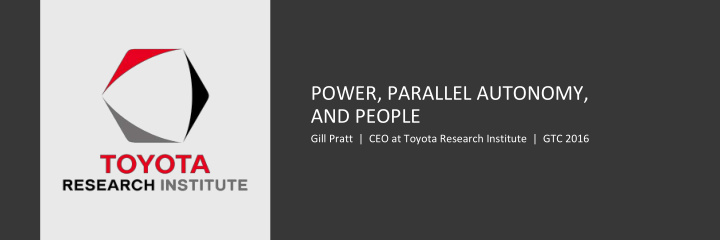



POWER, PARALLEL AUTONOMY, AND PEOPLE Gill Pratt | CEO at Toyota Research Institute | GTC 2016
1.2 Million People
How much power should it take Part 1: Power to drive an autonomous car?
CURRENTLY: THOUSANDS OF WATTS
Another Solution 30 W Works even while daydreaming
How Does It Do That ?
DARPA M3-Actuation
Energy efficiency is improved by sparse utilization of complexity Approved for Public Release, Distribution Unlimited
DARPA Neovision2: Sparse utilization of computing complexity can improve energy efficiency as well Approved for Public Release, Distribution Unlimited
DARPA SYNAPSE: BRAINS VS. VON NEUMANN COMPUTERS Computers Brains • Complexity Highly Constrained • Complexity Less Constrained Xbox One 28 nm SoC: 5 x 10 9 Transistors › Human Brain: 10 14 synapses 20,000 : 1 › • SWaP Less Constrained • SWaP Highly Constrained › IBM Sequoia Blue Gene/Q (98,304 16-core Power-PC chips) › Human Brain simulating 5 x 10 13 synapses 1 : 500,000,000 › 30 W › 8 Million Watts @ 1/1000 real time 1 : 300,000,000 › 3 pounds › 500,000 pounds @ 1/1000 real time • Sparse, Distributed Computation • Von Neumann Architecture › Dedicated Functionality › Multiplexed Functionality › Unary (Spike) Coding › Binary Coding Approved for Public Release, Distribution Unlimited
DARPA SyNAPSE: IBM True North SyNAPSE Chip: 5 Billion Transistors 256 Million Synapses (1 Human Brain / 400,000) 50 mW @ real time 3 x 10 -13 W/synapse (Brain) : 2 x 10 -10 W/synapse (SyNAPSE) 1 : 1000
CONCLUSION: POWER • Buy More Hardware • Unroll Computations • Avoid Multiplexers • Turn Most Hardware Off Most of the Time
Part 2: Must we achieve Level 4 to deal Parallel Autonomy with the handoff problem?
DARPA Robotics Challenge (Finals - June, 2015)
24 Teams Came From Around the World DARPA Approved for Public Release, Distribution Unlimited
Program Structure DARPA Approved for Public Release, Distribution Unlimited
SOME FELL OVER
SOME DID GREAT (KAIST)
MODEL BASED SERIES AUTONOMY 1 𝐵𝑣𝑢𝑝𝑜𝑝𝑛𝑧 ∝ 𝐷𝑝𝑛𝑛𝑣𝑜𝑗𝑑𝑏𝑢𝑗𝑝𝑜 Operator Degraded Network Emulator DRC Robot DARPA Approved for Public Release, Distribution Unlimited
DARPA ARM-S – LIMITING CASE OF 0 POST-COMMAND COMMUNICATIONS (JPL) DARPA Approved for Public Release, Distribution Unlimited
Is This the Only Model of Autonomy ?
Three modes of shared control
PARALLEL AUTONOMY: BRAIN COMPUTER INTERFACE ON QUADRIPLEGIC BOX AND BLOCKS 2-MINUTE TIMED TEST ARM + RP Collaboration PM : Gill Pratt (DSO) in collaboration with Justin Sanchez (BTO) Performers: CMU/NREC (Bagnell et. al.) + U. Pittsburgh (Schwartz et. al.) DARPA Approved for Public Release, Distribution Unlimited
How Does this Apply to Autonomous Driving ?
AKIO TOYODA’S PRIORITIES • Safety • Environment • Mobility for All • Fun to Drive
NEEDED RELIABILITY NUMBERS • About 10 Million Toyota cars are produced / yr. • Each car lasts about 10 years › About 100 Million Toyota cars are in service • Each car is driven about 10 thousand miles / yr. › Toyota cars are driven about 1 Trillion miles / yr. • It takes only a few defect-caused accidents / yr. to cause an existential crisis
SERIES (CHAUFFER) VS. PARALLEL (GUARDIAN ANGEL) Aspect Chauffer (Series Autonomy) Guardian Angel (Parallel Autonomy) Note: Technology Supporting Guardian Angel + Chauffer are Duty Cycle 100% < 1% : only if accident imminent similar Liability Manufacturer Mostly Driver Required Competence All of Driving Do No Harm Development All or Nothing Incremental lives lost until done lives saved sooner Driver’s Skills Ignored Utilized as much as possible Decreased Increased Fun + Love of Car car becomes train allows high performance experience by novice drivers Handoff Problem ? Yes No
SERIES (CHAUFFER) VS. PARALLEL (GUARDIAN ANGEL) Series Hybrid (Convenience) Autonomy Time, Complexity Chauffer Medium Speed Auto Driving Slow Speed Auto Driving Automatic Highway Passing Lane Keeping No Hands Automatic Parking Adaptive Cruise Speed Guardian Speeding Cruise Warn Angel Prevention Parallel ABS ASC NAV Collision Side Collision Lane Front Lane Collision Avoidance Collision Avoidance Collision Departure Departure Avoidance (Safety) Braking Warn Warn Steering Warn Prevention Acceleration Time, Complexity
TRI’S AUTONOMY RELATED GOALS • Improve Safety • Improve Access • Diversify Toyota from Mobility Outdoors to Mobility Indoors
But What About the Trillion Miles ?
SIMULATION • Repeatable Studies of Human – Machine Interface • Regression Testing for Software Development • Amplification of Physical Testing
Part 3: People
TRI ANN ARBOR (TRI-ANN) Ann Arbor Palo Alto Cambridge ~50 People ~150 People ~50 People Guardian Angel Simulation Chauffer
WHY ANN ARBOR ? University of M-City, Mobility American Center for Toyota Technical Michigan Transformation Center Mobility (Planned) Centers
TRI-ANN ARBOR AREA LEADS Prof. Ryan Eustice Prof. Ed Olson Area Lead, Mapping / Localization Area Lead, Perception
DIDN’T THEY USED TO WORK FOR FORD ? Ford Edison Assembly Plant, Metuchen, NJ, March 1961
“CO - OPETITION” ACCELERATES PROGRESS Eiji Toyoda visiting Ford River Rouge Plant, ca. 1950
Our Hope: Car Manufacturers Constructive IT Companies Governments Competition and Hardware Manufacturers Collaboration
Why Co-operate?
1.2 Million People Per Year Demand Nothing Less
CONCLUSION : FIRST EVER BCI DOOR OPENING ARM + RP Collaboration PM : Gill Pratt (DSO) in collaboration with Justin Sanchez (BTO) Performers: CMU/NREC (Bagnell et. al.) + U. Pittsburgh (Schwartz et. al.) DARPA Approved for Public Release, Distribution Unlimited
Thank You NVIDIA !
Recommend
More recommend